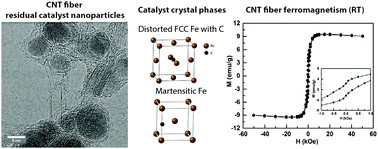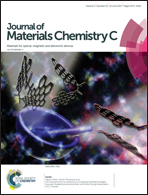Carbon nanotube fibers with martensite and austenite Fe residual catalyst: room temperature ferromagnetism and implications for CVD growth†
Abstract
We report on the room temperature ferromagnetic properties of continuous macroscopic fibers made up of carbon nanotubes grown by floating catalyst chemical vapor deposition. Their ferromagnetic behavior originates from the presence of residual catalyst nanoparticles: martensite with 0.77 wt% C content and FCC Fe. The first is intrinsically ferromagnetic, but the latter only due to severe lattice distortion as a consequence of C supersaturation. The stabilization of martensite and austenite occurs mainly because of the small diameter of the nanoparticles, in the range of 4–20 nm. This is smaller than the embryonic nucleus of the relevant equilibrium phases, but also implies that large C concentrations can build up in FCC Fe before C can be segregated as a stable graphitic nucleus. The room temperature remanence ranges from 10% to 25% and the coercivity from 55 to 300 Oe, depending on the choice of promoter for fiber synthesis (S or Se). Superparamagnetic behavior is only observed in S-grown samples on account of the smaller diameter of residual catalyst particles. The results of this work provide an explanation for the widespread observation of magnetic properties in oxide-free CNT samples produced by catalytic growth under a wide range of synthesis conditions.



 Please wait while we load your content...
Please wait while we load your content...